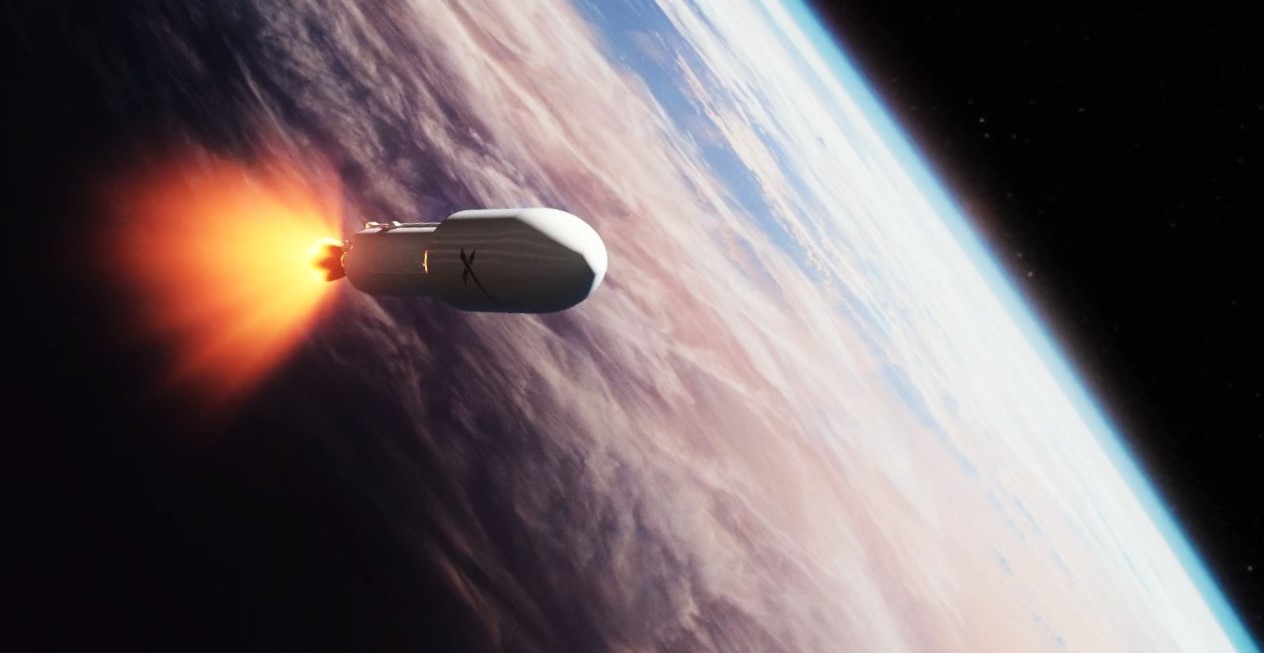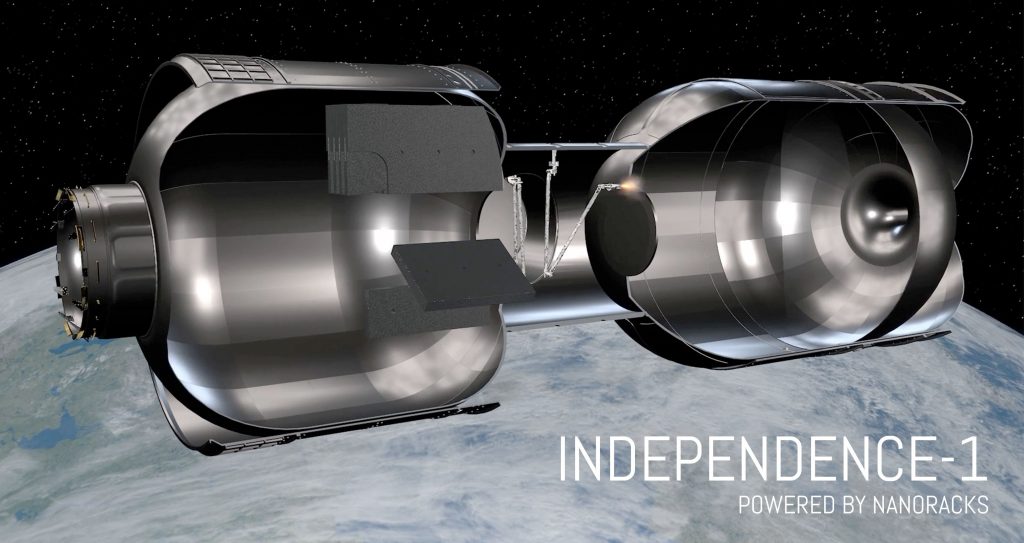

News
SpaceX Falcon 9 rideshare will test the tools needed to build space stations in orbit
A SpaceX customer has announced that one of a future Falcon 9 rideshare missions will carry a technology demonstrator designed to prove that space stations can one day be built in space by cannibalizing expended rocket upper stages.
On November 18th, commercial space company Nanoracks revealed that it had manifested its first “In-Space Outpost” mission on one of SpaceX’s recently-announced Falcon 9 rideshare missions, scheduled to launch as early as Q4 2020. Known for its successful efforts to use the International Space Station’s capabilities to affordably deploy hundreds of commercial small satellites, Nanoracks has also branched out into organizing rideshare opportunities for smallsats on much larger launches, another method of lowering costs.
Most recently, however, Nanoracks began to pursue a new venture centered around building unprecedentedly affordable human-rated space stations in Earth orbit. While not fundamentally new, Nanoracks proposed a unique solution: modify expended launch vehicle upper stages already in orbit to build space stations in-situ.
It’s anyone’s guess whether such a concept can actually produce safe, affordable space stations and do so more effectively than the obvious alternative of designing, building, and launching already-finished space station components. Nevertheless, Nanoracks has firmly decided to attempt the feat. The technical hurdles alone will require numerous in-space demonstrations of custom hardware, and the Outpost Nanoracks has manifested on a Q4 2020 Falcon 9 rideshare mission will be the first of those attempted demonstrations.
“As a member of the Outpost program team, Maxar will develop a new articulating robotic arm with a friction milling end-effector for this mission. This friction milling will use high rotations per minute melting our metal material in such a way that a cut is made, yet we anticipate avoiding generating a single piece of orbital debris.
The mission is targeting a Q4 2020 dedicated rideshare mission, will fly on an ESPA ring, and will activate after the deployment of all other secondary payloads is complete. As our mission commences, we will have 30 minutes to one hour to complete the cutting of three metal pieces that are representative of various vehicle upper stages, including the Centaur 3. Nanoracks plans to downlink photos and videos of the friction milling and cutting.”
Nanoracks, 11/18/19

As described above, the first Outpost test will focus on proving that the metal tanks of upper stages can be manipulated and cut in orbit with robotic arms to be built by Maxar. The experimental mission will reportedly take place while the payload is still attached to Falcon 9’s upper stage payload adaptor and will carry along three separate propellant tank coupons instead of attempted to mill and cut Falcon 9 itself.
As one of SpaceX’s proposed rideshare missions, Nanoracks will likely be just one of a few dozen other customers or spacecraft catching a ride, and the Outpost experiment will only begin after all other satellites have successfully deployed. Earlier this year, SpaceX announced that Smallsat Rideshare Program and rapidly modified it soon after, adding numerous new launch opportunities and lowering the base price to from ~$2.25M (150 kg) to $1M for 200 kg (440 lb) of spacecraft or experiments. Aside from 3-4 annual dedicated launches, SpaceX also plans to reserve some amount of space on certain Starlink launches, dozens of which are currently planned annually.
Nanoracks’ Outpost-1 mission is expected to launch no earlier than Q4 2020.
Check out Teslarati’s Marketplace! We offer Tesla accessories, including for the Tesla Cybertruck and Tesla Model 3.

News
Tesla (TSLA) receives “Buy” rating and $551 PT from Canaccord Genuity
He also maintained a “Buy” rating for TSLA stock over the company’s improving long-term outlook, which is driven by autonomy and robotics.

Canaccord Genuity analyst George Gianarikas raised his Tesla (NASDAQ:TSLA) price target from $482 to $551. He also maintained a “Buy” rating for TSLA stock over the company’s improving long-term outlook, which is driven by autonomy and robotics.
The analyst’s updated note
Gianarikas lowered his 4Q25 delivery estimates but pointed to several positive factors in the Tesla story. He noted that EV adoption in emerging markets is gaining pace, and progress in FSD and the Robotaxi rollout in 2026 represent major upside drivers. Further progress in the Optimus program next year could also add more momentum for the electric vehicle maker.
“Overall, yes, 4Q25 delivery expectations are being revised lower. However, the reset in the US EV market is laying the groundwork for a more durable and attractive long-term demand environment.
“At the same time, EV penetration in emerging markets is accelerating, reinforcing Tesla’s potential multi‑year growth runway beyond the US. Global progress in FSD and the anticipated rollout of a larger robotaxi fleet in 2026 are increasingly important components of the Tesla equity story and could provide sentiment tailwinds,” the analyst wrote.
Tesla’s busy 2026
The upcoming year would be a busy one for Tesla, considering the company’s plans and targets. The autonomous two-seat Cybercab has been confirmed to start production sometime in Q2 2026, as per Elon Musk during the 2025 Annual Shareholder Meeting.
Apart from this, Tesla is also expected to unveil the next-generation Roadster on April 1, 2026. Tesla is also expected to start high-volume production of the Tesla Semi in Nevada next year.
Apart from vehicle launches, Tesla has expressed its intentions to significantly ramp the rollout of FSD to several regions worldwide, such as Europe. Plans are also underway to launch more Robotaxi networks in several more key areas across the United States.
News
Waymo sues Santa Monica over order to halt overnight charging sessions
In its complaint, Waymo argued that its self-driving cars’ operations do not constitute a public nuisance, and compliance with the city’s order would cause the company irreparable harm.

Waymo has filed a lawsuit against the City of Santa Monica in Los Angeles County Superior Court, seeking to block an order that requires the company to cease overnight charging at two facilities.
In its complaint, Waymo argued that its self-driving cars’ operations do not constitute a public nuisance, and compliance with the city’s order would cause the company irreparable harm.
Nuisance claims
As noted in a report from the Los Angeles Times, Waymo’s two charging sites at Euclid Street and Broadway have operated for about a year, supporting the company’s growing fleet with round-the-clock activity. Unfortunately, this has also resulted in residents in the area reportedly being unable to sleep due to incessant beeping from self-driving taxis that are moving in and out of the charging stations around the clock.
Frustrated residents have protested against the Waymos by blocking the vehicles’ paths, placing cones, and “stacking” cars to create backups. This has also resulted in multiple calls to the police.
Last month, the city issued an order to Waymo and its charging partner, Voltera, to cease overnight operations at the charging locations, stating that the self-driving vehicles’ activities at night were a public nuisance. A December 15 meeting yielded no agreement on mitigations like software rerouting. Waymo proposed changes, but the city reportedly insisted that nothing would satisfy the irate residents.
“We are disappointed that the City has chosen an adversarial path over a collaborative one. The City’s position has been to insist that no actions taken or proposed by Waymo would satisfy the complaining neighbors and therefore must be deemed insufficient,” a Waymo spokesperson stated.
Waymo pushes back
In its legal complaint, Waymo stated that its “activities at the Broadway Facilities do not constitute a public nuisance.” The company also noted that it “faces imminent and irreparable harm to its operations, employees, and customers” from the city’s order. The suit also stated that the city was fully aware that the Voltera charging sites would be operating around the clock to support Waymo’s self-driving taxis.
The company highlighted over one million trips in Santa Monica since launch, with more than 50,000 rides starting or ending there in November alone. Waymo also criticized the city for adopting a contentious strategy against businesses.
“The City of Santa Monica’s recent actions are inconsistent with its stated goal of attracting investment. At a time when the City faces a serious fiscal crisis, officials are choosing to obstruct properly permitted investment rather than fostering a ‘ready for business’ environment,” Waymo stated.
News
Tesla FSD v14.2.2 is getting rave reviews from drivers
So far, early testers have reported buttery-smooth drives with confident performance, even at night or on twisty roads.

Tesla Full Self-Driving (Supervised) v14.2.2 is receiving positive reviews from owners, with several drivers praising the build’s lack of hesitation during lane changes and its smoother decision-making, among others.
The update, which started rolling out on Monday, also adds features like dynamic arrival pin adjustment. So far, early testers have reported buttery-smooth drives with confident performance, even at night or on twisty roads.
Owners highlight major improvements
Longtime Tesla owner and FSD user @BLKMDL3 shared a detailed 10-hour impression of FSD v14.2.2, noting that the system exhibited “zero lane change hesitation” and “extremely refined” lane choices. He praised Mad Max mode’s performance, stellar parking in locations including ticket dispensers, and impressive canyon runs even in dark conditions.
Fellow FSD user Dan Burkland reported an hour of FSD v14.2.2’s nighttime driving with “zero hesitations” and “buttery smooth” confidence reminiscent of Robotaxi rides in areas such as Austin, Texas. Veteran FSD user Whole Mars Catalog also demonstrated voice navigation via Grok, while Tesla owner Devin Olsen completed a nearly two-hour drive with FSD v14.2.2 in heavy traffic and rain with strong performance.
Closer to unsupervised
FSD has been receiving rave reviews, even from Tesla’s competitors. Xpeng CEO He Xiaopeng, for one, offered fresh praise for FSD v14.2 after visiting Silicon Valley. Following extended test drives of Tesla vehicles running the latest FSD software, He stated that the system has made major strides, reinforcing his view that Tesla’s approach to autonomy is indeed the proper path towards autonomy.
According to He, Tesla’s FSD has evolved from a smooth Level 2 advanced driver assistance system into what he described as a “near-Level 4” experience in terms of capabilities. While acknowledging that areas of improvement are still present, the Xpeng CEO stated that FSD’s current iteration significantly surpasses last year’s capabilities. He also reiterated his belief that Tesla’s strategy of using the same autonomous software and hardware architecture across private vehicles and robotaxis is the right long-term approach, as it would allow users to bypass intermediate autonomy stages and move closer to Level 4 functionality.








